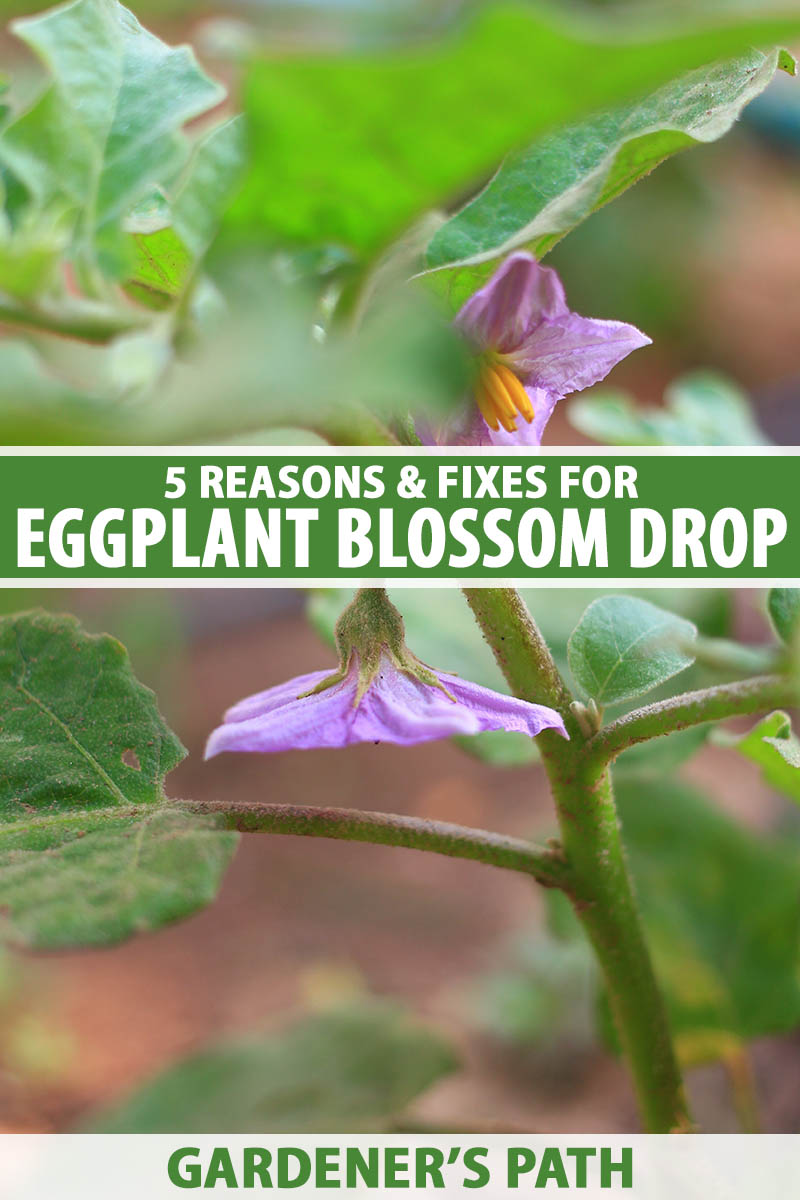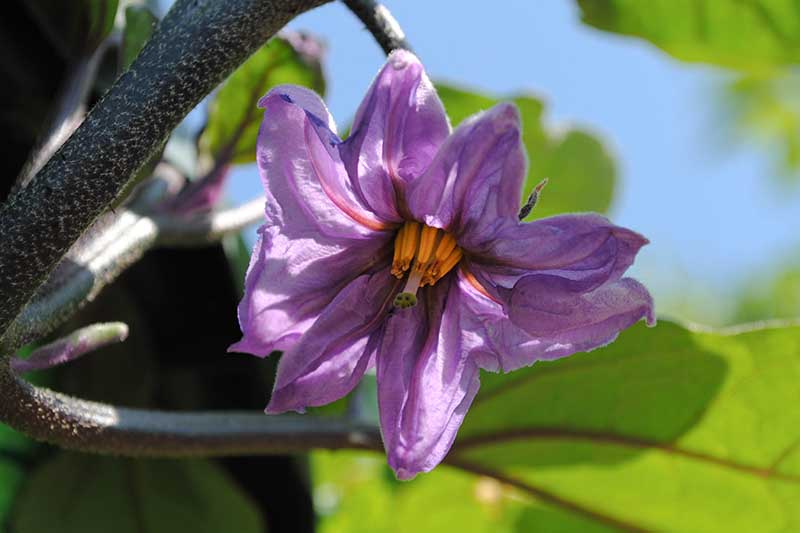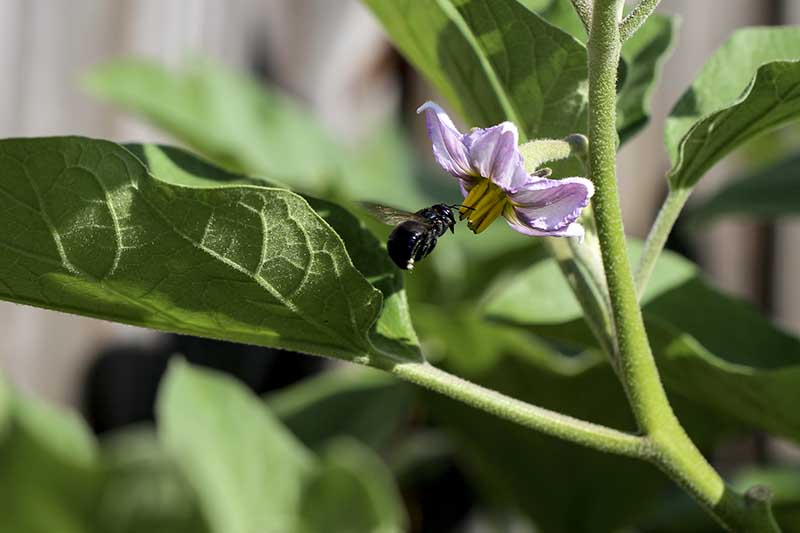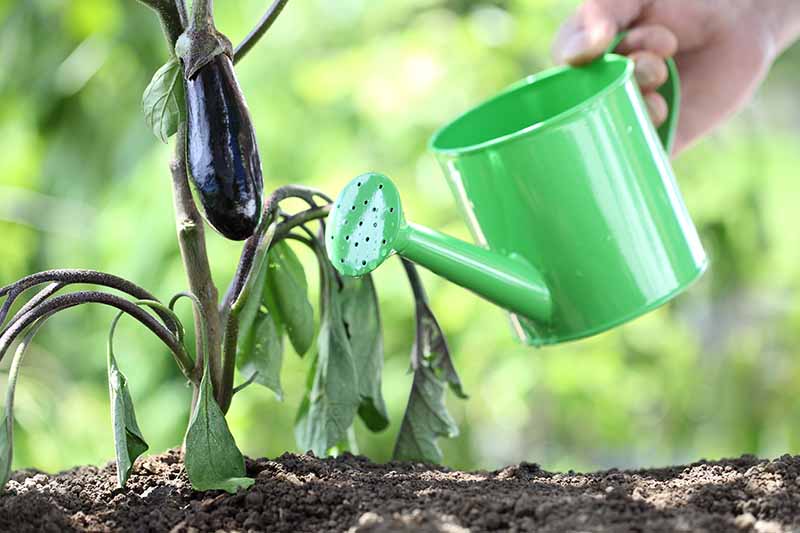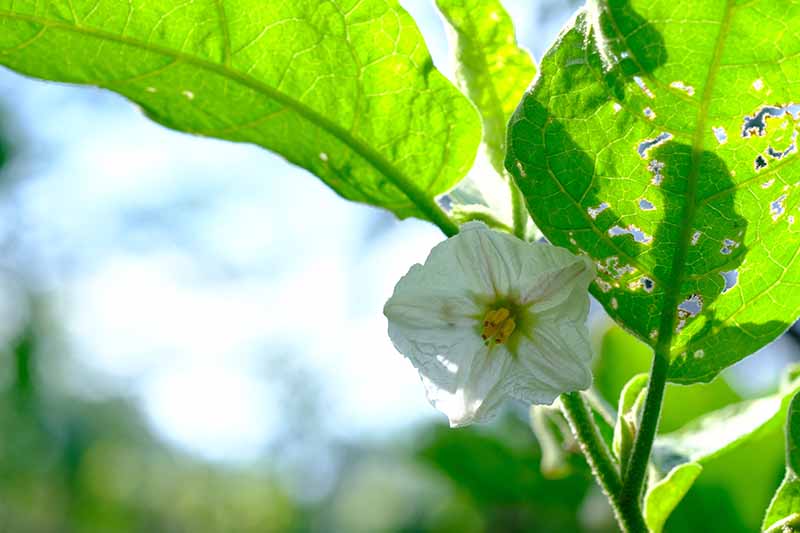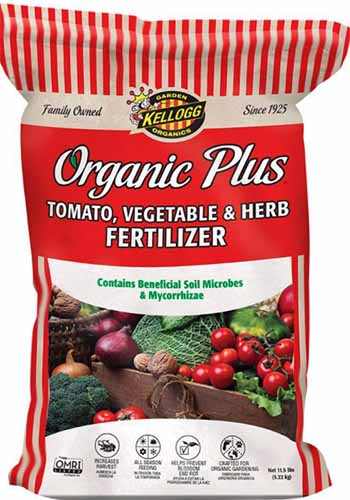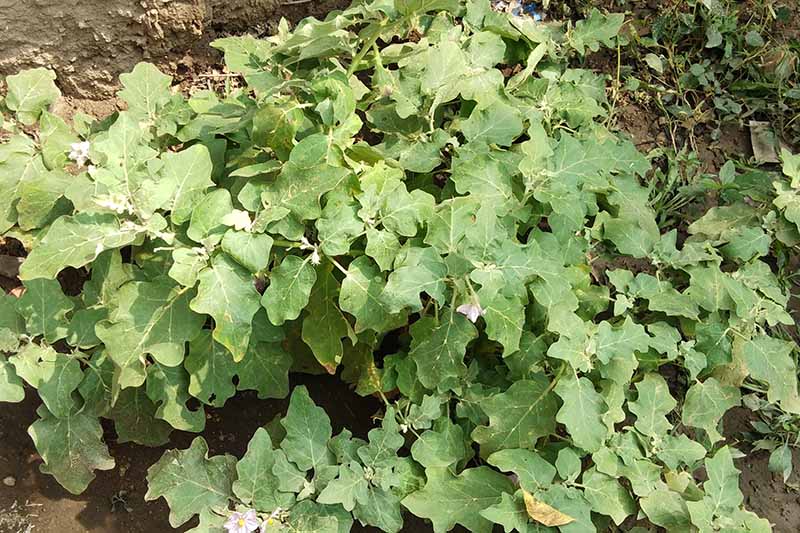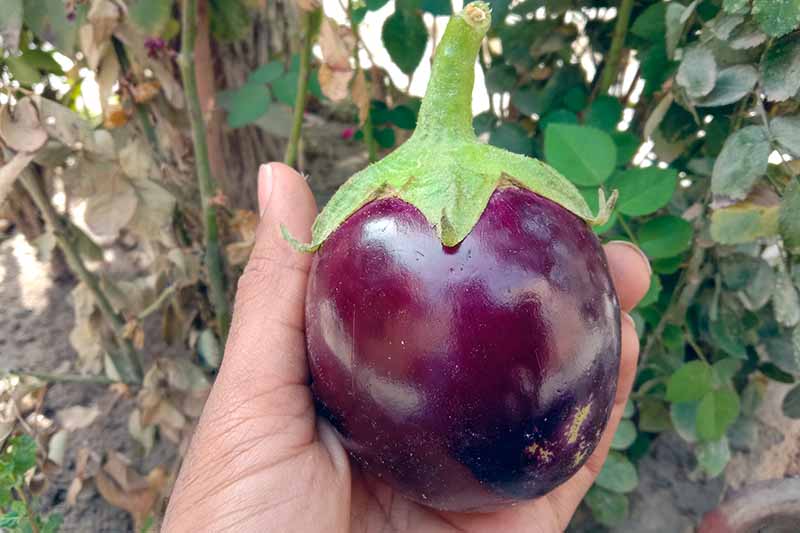And there’s no worse feeling than watching those hard-earned blossoms drop right off the plant and into the waiting dirt. You might be wondering if the flowers are supposed to fall off at some point. Or maybe they’re purple and pretty, and then they seem to drop for no reason that you can come up with. In this guide, we’ll help you figure out what’s going on with your prized aubergines. We link to vendors to help you find relevant products. If you buy from one of our links, we may earn a commission. Here’s the lineup:
1. Failure to Self-Pollinate
Maybe the wind never blew briskly enough to dislodge pollen from the anthers. Or maybe bees never landed on the anthers and buzzed the pollen out of its hiding place. Or maybe the reasons are trickier. If the humidity in your area is high, the pollen might have turned sticky, making it difficult for it to travel from the anthers to the stigma regardless of the presence of wind or bees. For whatever reason, your blossoms are dropping without producing fruit, and it’s making you frustrated. Thankfully, there’s plenty you can do to help bring pollination about if you notice that blossoms are falling off without producing any fruit. The easiest way to aid pollination is to tap the top of each flower several times, essentially recreating the work a strong wind would do. Or, you can gently rub the anthers and stigma with a clean paintbrush, traveling from flower to flower to redistribute the pollen. Act like a bumblebee, and grab a clean electric toothbrush. Turn it on, and touch the anthers and stigma with it. Really, all you need to do is gently buzz the toothbrush on the inside (the yellow part) of the flower. Within a few days, your newly pollinated blossoms should give way to tiny baby eggplants. Read our detailed guide on pollinating by hand. But what if the flowers are falling off right after they open? Or even after you’ve pollinated them by hand? What could be the culprit? It’s time to think about hydration.
2. Too Much Water – Or Too Little
Stress is at the root of many of an eggplant’s problems. (Not so different from us!) When it comes to water, aubergines like to receive at least one deep, slow watering once a week. Soil should never dry out completely, so if you poke your finger an inch down into the soil a few days after watering and it feels bone dry, it’s past time to water again. And when it’s extra hot in your area, you’ll want to check the soil moisture daily. If you don’t water your S. melongena deeply or often enough, in the absence of rain, the plant will become stressed, and it will drop blossoms in order to focus its nutrients and redirect its energy toward surviving. Conversely, if you overwater the plant and it’s constantly left in standing water, that’s going to negatively affect blossom development, too. Eggplants are not fans of wet feet, or oversaturated soil. But when you take care to water it just the right amount, checking the soil moisture often, you should be able to keep it happy. As long as it doesn’t get too hot, that is. Because with fluctuating temperatures comes a whole host of problems for your S. melongena.
3. Stressful Temperatures
When it comes to growing aubergines, the ideal growing temperatures fall within a range of 70 to 95°F during the day and 55 to 70°F at night. Anything outside of this range can stress the plant and cause blossoms to drop. The best way to prevent unpleasant surprises in this department is to keep an eye on the forecast. Check your weather app every day. If you see a couple days of temperatures below 70°F during the day and 55°F at night are predicted, add an extra two-inch layer of organic mulch around each eggplant. I love using wood chips, straw, or grass clippings. When I was a kid, my mom used Kozy Coats on her tomato plants in our Montana garden. She explained to me that they were basically miniature greenhouses. Another fantastic option is to buy a pack of Kozy Coats, available in a three-pack from Burpee. Kozy Coats Just fill the tubes with water and place one Kozy Coat around each susceptible plant. Sunlight will heat up the water, creating a warm, insulated space around your eggplants that can protect them in temperatures down to 16°F. If you live in Zones 4, 5, 6, or even 7 and are growing aubergines, Kozy Coats can mean the difference between life or death for your plants! But what if you live in a warmer growing zone where temperatures regularly rise above 95°F during the day and 70°F at night? How can you keep the blossoms happy? Once again, mulch is your friend, in this case because it helps maintain soil moisture and prevents it from drying out too quickly. Consider erecting a shade cloth over your plants until the heat wave is over. This can help keep the plant slightly cooler in the heat of the day, helping to prevent heat-induced blossom drop. If you’re growing your aubergine in a container, just move it to a shady area for a few days. In the shade, temperatures can be 10 to 15 degrees cooler – a game changer for your aubergines. You’ll also want to check the soil moisture every day during a heat wave, preferably in the morning before it gets too hot. Early morning waterings are ideal because they give the roots a chance to drink up the moisture before the heat can pull it right back out of the soil, which is what happens if you attempt to water your plants during the hottest part of the day. During heat waves, you may need to provide one deep, long soaking every other day in the early morning. If you’re growing in containers, you might need to water them daily since soil in containers dries out more quickly. If a heat wave catches you off guard and your blossoms drop because of it, don’t fret too much. Do what you can to ease the plant’s stress. Once the hot weather passes, plants that have been well cared for will recover, and new blossoms will form. Now, if you’ve taken care of pollination, aren’t suffering from excess heat or cold snaps, and your eggplant is growing tall and leafy but isn’t producing any flowers at all, read on to find out what might be happening.
4. Planting Too Late – Or Too Early
Eggplants take a long time to mature – typically between 100 and 120 days after germination. Starting seeds indoors eight to 10 weeks before your area’s average last frost date is recommended in order to ensure success. But even then, those of us in colder growing zones might not have enough time to see them produce fruit. A “cold snap” of anything below 70°F during the day and anything below 55°F at night can stress out the plants and cause blossom drop, as we discussed above. It can be hard to avoid these temperatures, especially in Zones 4 or 5, where the average high in September can be 58°F. (I’m looking at you, Alaska!) An easy way to help avoid blossom drop from a too-short growing season is to plant early-maturing varieties in colder regions. A few choices to consider are: Otherwise, start with seedlings that are ready to transplant. ‘Early Midnight’ Seeds in packets of 35 or sets of three plants are available from Burpee.
Hansel
‘Hansel,’ a hybrid producing four- to 10-inch fruits, depending on how long you leave them on the plant, and that mature in 55-60 days. ‘Hansel’ You can find seeds in a variety of packet sizes available from True Leaf Market.
Patio Baby
‘Patio Baby,’ another hybrid that produces 25-50 tiny, three- to four-inch dark-purple eggplants and matures in 45 days. ‘Patio Baby’ Seeds in packets of 30 or sets of three plants are available from Burpee. You’ll still need to make sure you start these varieties indoors eight to 10 weeks before the average last frost date if you are starting with seeds, to ensure they have as much time as possible to grow and thrive. By the time the temperatures drop, you’ll already have harvested a satisfying crop of ripe, delicious fruits from your plants.
5. Over- or Under-Fertilization
When your plant is a seedling, you’ll want to provide it with a balanced vegetable fertilizer about once a month according to package instructions. I always use a 5-5-5 (NPK) at the beginning. But as soon as the first blossoms appear, switch away from this general-purpose fertilizer. At this point, your plant needs less nitrogen, and too much of this nutrient can prevent flowers from developing. Don’t get me wrong: nitrogen is an essential plant nutrient that is definitely necessary during the first phase of an eggplant’s life in particular. It’s essential for leaf production. But once the first flowers appear, it’s time to focus on fertilizer that provides a higher ratio of phosphorus, which plays an essential role in producing flowers and fruits. While an overabundance of nitrogen can keep flowers from developing, it’s not likely to cause existing flowers to drop if you accidentally over-fertilize. Organic Plus Tomato, Vegetable, and Herb Fertilizer Once the plant enters the flowering phase, excess nitrogen can cause your eggplant to develop more leaves than it needs at the expense of flowers and fruit. If you notice that you have too many leaves and not enough flowers, just adjust your fertilization habits and blossoms should soon appear. Succulent, savory eggplants are most definitely in your future. Have you ever fixed a blossom drop issue with your aubergines? Share your stories and questions in the comments section below. And if you want to learn more about growing eggplant and the many varieties S. melongena to choose from, check out these articles next:
21 of the Best Japanese Eggplant Varieties9 of the Best White Eggplant VarietiesEggplant Spacing: How Far Apart to Plant
